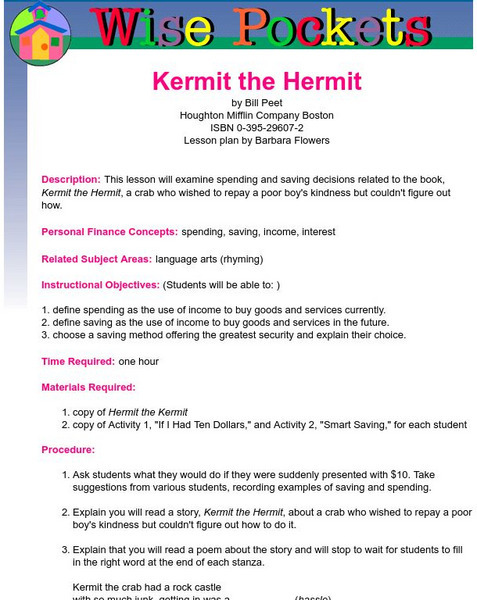Practical Money Skills
Visa: Practical Money Skills for Life
Visa provides a resource that teachers, parents, and students will all enjoy using. There are lesson plans here for all ages, as well as information about spending decisions, budgeting, and money management. Print your own play money,...
Khan Academy
Khan Academy: Lesson Summary: Definition, Measurement, and Functions of Money
This information is intended for AP Macroeconomics students or for those taking college macroeconomics. This lesson reviews key terms and calculations related to the definition, measurement, and functions of money. Topics include the...
Teachnology
Teachnology: Math Lesson Plans
Great lesson plans covering a wide-range of math-related subjects.
Better Lesson
Better Lesson: Want to Trade?
Students will write about what they would trade for gold and practice inventive spelling in the process. After reading "In 1492", students will discuss how Christopher Columbus traded with the natives and then write what they would trade...
Smithsonian Institution
Smithsonian Learning Lab: What Shape Is Money? Money Doesn't Have to Be Round or Rectangular
Pigs, rice, nuts, teeth, eggs, feathers - these are all types of currency! This lesson discusses different types of objects that can be used as currency and students will decide what qualities make an effective currency. Included are...
Council for Economic Education
Econ Ed Link: Do I Look Like I'm Made of Money?
One of the most common replies given by parents when their children ask for money is "Do I look like I'm made of Money?" This lesson is designed to educate learners about the need for money as a generally accepted medium of exchange. The...
Better Lesson
Better Lesson: Time and Money
As the result of a Unit assessment, it was found that students showed some confusion with writing time and with adding sets of coins. These skills need to be reviewed to aid in mastery of the Common Core standards for time and money.
Better Lesson
Better Lesson: More Dimes and Dollars
Second graders need practice using coins and dollars and relating them to ones, tens and hundreds. Common Core standards include counting by 10s and 100s.
University of Regina (Canada)
University of Regina: Math Central: Time, Money, and Temperature Lesson Plans
Money, time, and temperature are developed through several lessons. These topics of measurement are explained with suggested lessons, evaluations, instructional methods, and resources.
Practical Money Skills
Practical Money Skills for Life: Lesson Plans
A series of financial literacy lesson plans broken out by grade range for grades from Pre-K through college, with an additional set of lessons created for students with special needs.
Khan Academy
Khan Academy: Lesson Summary: Monetary Policy
This lesson from Khan Academy is intended for students who are taking the AP Chemistry course or a college chemistry class. This lesson summary reviews key terms and graphs related to money. Topics include the tools of monetary policy,...
AAA Math
Aaa Math: Aaa Math Lessons
AAA Math's interactive tutorials and lessons assist students grades K-8 improve their understanding of a wide range of arithmetic topics. Students are provided with immediate feedback as they complete the "Learn," "Practice," and "Play"...
Scholastic
Scholastic: Adventures in Math: Lesson 3: Money in Our Community
Lesson focuses on how and why money circulated within our community. Being able to discern the difference between things we need and things we want is one of the foundational concepts for using money wisely. Goods and services are things...
Scholastic
Scholastic: Adventures in Math: Lesson 1: Money Matters
The process of earning money is the cornerstone of financial literacy. For this lesson, young scholars will identify key terms associated with earning money, explore ideas for earning money now, and evaluate various career options as...
University of Missouri
University of Missouri: Wise Pockets: Four Dollars and Fifty Cents
This is a lesson plan geared towards elementary level students. Using the book Four Dollars and Fifty Cents by Eric Kimmel, the teacher instructs students about the terms creditor, debtor, collateral, credit, and credit report. Lesson...
Better Lesson
Better Lesson: Identifying Coins
Find a lesson plan here to help students learn more about money that is all around them! Give them the chance to review coin identification with the coin game and practice.
Better Lesson
Better Lesson: Hundreds, Tens, Ones Are Coins Too
Second graders will extend their understanding of hundreds, tens and ones using dollars, dimes and pennies as another way to express groups of 100, 10 and 1.
Better Lesson
Better Lesson: Cheerful Shoppers
Second graders love to shop! Students will use their own shopping list to compose a word problem using addition and subtraction with and without regrouping, in order to help them better understand how to problem solve.
Alabama Learning Exchange
Alex: An Interest Ing Math Lesson
Eventually, everyone will need to borrow money for one reason or another. A good understanding of how interest works will go a long way when applying for a loan. In this lesson, middle schoolers will complete a KWL chart about the...
University of Missouri
University of Missouri St. Louis:wise Pockets: Kermit the Hermit
This is an elementary level lesson that deals with spending, saving, income, and interest. Requires the book Kermit the Hermit by Bill Peet. Includes detailed lesson plan along with procedures and activities.
Other
Money Management International: The Berenstain Bears' Trouble With Money
A lesson plan featuring the Berenstain Bears that introduces the concepts of spending, goods, services, income, saving, and interest.
Council for Economic Education
Econ Ed Link: Where Does the Money Come From?
With very few exceptions, the U.S. federal government does not have an "income" to spend providing goods and services. The money used for federal spending programs must be collected as federal taxes, or it must be borrowed. This lesson...
Better Lesson
Better Lesson: Multiplying Decimals by Whole Numbers
Multiplying decimals is a life skilled used in purchasing goods, cooking, and spending money.
Better Lesson
Better Lesson: Loans and Savings
What are loans and how do they work? How do banks encourage people to save money? Students work on these questions in the context of the College Project.
Other popular searches
- Money Lessons Giving Change
- Counting Money Lessons
- Canadian Money Lessons
- Second Grade Money Lessons
- 2nd Grade Money Lessons
- Australian Money Lessons
- Shopping Money Lessons
- Math Money Lessons
- Money Lessons Elementary
- Fun Money Lessons
- Counting Money Math Lessons
- Adding Money Amounts Lessons















